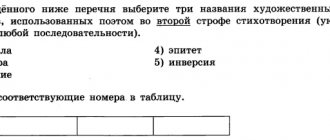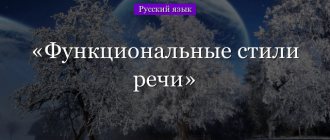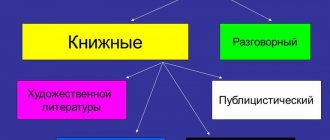Updated July 23, 2022 283 Author: Dmitry Petrov
Hello, dear readers of the KtoNaNovenkogo.ru blog. Today we will talk about such a term as TRAILS, which are actively used in literature.
Although in our everyday speech we constantly use these techniques without even knowing it.
For example, when we praise our father’s golden hands, we are afraid to buy a pig in a poke, or we say that we waited half a day, although in fact only fifteen minutes have passed.
Paths - means of expressive speech
What is a trope?
The linguistic term "trope" literally means "turn" in Greek. It is called a figurative turn of speech created by an artist of words, based on a rethinking of the direct meaning of the word and the emergence of a new, figurative meaning. The trope is based on a comparison of two phenomena that are similar to each other in some aspects or characteristics. The author, using the signs of one phenomenon, characterizes another object with their help, trying to explain it and at the same time create a vivid, figurative idea about it in the reader.
The music rang in the garden with such inexpressible grief. The fresh and pungent smell of the sea On a platter were oysters in ice.
A. Akhmatova. In the evening.
Definition
Let us define what a trope is.
Definition
A trope is a figurative figure of speech in which a word or expression is used in a figurative meaning based on the comparison of two objects or phenomena related to each other by semantic relations.
A trope can be called a form of poetic thinking. An artist of words easily manipulates words, creating new combinations of words in artistic speech, which in an unusual proximity to each other create an unexpectedly bright and visible image:
Poetic stylistic figures
The list doesn't end with just ten examples.
All of them can be used in poetry with the same success as in prose, but some phrases are suitable specifically for poetics.
In addition to the main types of artistic means in literature, there are poetic tropes and figures of speech.
Table with examples:
| ALLITERATION | Repeating identical consonants in order to give the verse a special intonation. "Evening. Seaside. Sighs of the wind. The majestic cry of the waves. A storm is coming. A black boat, alien to enchantment, hits the shore...” (Balmont). |
| ASSONANCE | Repeating the same vowels in a stanza or line. “Oh, the infinitely beautiful sun... The sunset is equally beautiful!” |
| ANAPHORA | Repeat the initial word, one line or phrase. “You are poor, you are abundant, you are downtrodden, you are all-powerful, Mother Rus'!” (Nekrasov). |
| PARALLELISM | The same or similar arrangement of word forms in order to create a single poetic image. “You, Admiral, will leave the sea. You, admiral, will die of grief.” |
| RHYME | Rhyme is also considered a full-fledged trope, although it is familiar even to children. The consonance of the last stressed syllable in a line is called rhyme. It can be cross, as in the example (the first and third lines, the second and the fourth alternate), or parallel (the first rhymes with the second, the third with the fourth). “The sun is rolling into the sunset, soon something new will be born, the waves will reflect the glare, the world will be illuminated with rays.” |
The role of the trope in a work of fiction
Paths serve not only to clarify details, signs and other characteristics of a phenomenon. They, as artistic means, reveal the peculiarities of the creative thinking of the author of the work, who, with the help of various tropes, achieves a figurative picture of the surrounding world. To clearly explain this, let us remember how in his “Notes on Art” the artist N. Zhukov wrote about the variety of ways of figuratively artistic embodiment of an object or object of reality:
How to convey in words the impression of a very fat person? We can say that he is disproportionately fat. You can say it differently: he could hardly move. Or: I had difficulty entering the door. Or again: he was so thick that he resembled a ball. You can determine the thickness by saying that the person was short, he weighed 130 kg. There are hundreds of ways to determine body build. But here’s how convincingly the feeling of a full body can be conveyed through a detail: he was so fat that his cheeks were visible from his back. And you immediately feel how ordinary the previous examples were and how sharp the artist’s eye was, capturing the main thing in the image of the person standing in front of him.
As we can see, the artistic trope (he was so thick that his cheeks were visible from behind his back) helped the author create a visible and vivid image. With its help, the essence of the phenomenon is succinctly conveyed.
The use of tropes gives the phenomenon being described that meaning, a new shade of meaning that the author needs in a given speech situation, and also conveys his personal assessment of the phenomenon .
Main types
| COMPARISON | A phrase where several objects, situations, creatures, and so on are compared (compared). Comparative words are a mandatory element: “as”, “as if”, “as if”, “exactly” (meaning “as if”). “All like a rumpled bed”; "Crying like a baby." |
| EPITHET | A colorful evaluative definition with additional characteristics. "Bottomless Sky"; "Greedy Flame" |
| HYPERBOLA | Deliberate exaggeration in the description of phenomena. “A thousand suns were reflected on the waves”; "A sea of tasks." |
| LITOTES | The backfire of hyperbole: deliberate understatement. "Tom Thumb"; “I am a grain of sand in this world.” |
| METAPHOR | Transferring the characteristics of one object to another based on their similarity. This is a hidden comparison that does not use the words “as”, “as if”, and so on. “Walks like a bear”; "Forest Tent" |
| PERSONALIZATION | Intentional transfer of properties of living things to non-living things. "The clock is striking"; "It is raining". |
| IRONY | Allegory with slight mockery in order to create and convey a satirical image. “Where are you going, smart one, head? - the fox asked the donkey.” |
| INVERSION | Violation of the standard ordering of words, enhancing the expression of speech patterns. Most characteristic of folklore. “The stars thin at dawn, and the color turns pink.” |
| GROTESQUE | Portraying a subject in a comic light through contrasts and exaggeration. Most often used in folklore and character creation. Example: Koschey the Immortal. |
| OXYMORON | A type of antithesis (contrast). A paradoxical phrase with contradictory meaning. "Living Dead"; "Fire of Ice" |
All these are ways of playing with consciousness, embodying the images with which a person is accustomed to perceiving the environment, creating a special atmosphere. Images are a generalized distortion of reality , passed through the author’s inner world.
Types of tropes
The following types of tropes are used in artistic speech:
Table
| TRAILS | EXAMPLES |
| An epithet is an artistic definition that figuratively and emotionally characterizes the described phenomenon, person, object, event. | white little hands; red maiden; good fellow; clear month; scarlet dawn; wild little head; bitter share; biting frost; clear field; good horse. |
| Metaphor is the transfer of a name from one object or phenomenon of reality to another based on their similarity in some respect or contrast. | There was a golden time, but it disappeared. (A. Koltsov) The moon will smile all evening. (A. Chekhov) The ensigns fixed their eyes on the Tsar. (A. Tolstoy) |
| Metonymy is the transfer of a name from one object or phenomenon to another based on contiguity. | porcelain jug - I’ll pour the jug; crystal - there is crystal in the closet; buy a bedroom - enter the bedroom. |
| Synecdoche is an artistic trope that is created by transferring the name of an object from its part to the whole and vice versa. | All flags will be visiting us. (A.S. Pushkin) - Hey, beard! How to get from here to Plyushkin? (N.V. Gogol) Swede, Russian stabs, chops, cuts. (A.S. Pushkin) |
| Allegory is an artistic representation of ideas (concepts) through a specific artistic image or dialogue. | the kingdom of Morpheus is a dream; embrace of Hades - death; Fort Knox is inaccessible. |
| Hyperbole is a figurative expression consisting of an exorbitant exaggeration of the size, strength, and significance of the depicted phenomenon. | rivers of blood; you are always late; mountains of corpses; haven't seen each other for a hundred years; scare to death; I said it a hundred times; a million apologies; sea of wheat. |
| Litotes is a trope that has the meaning of understatement or deliberate softening. | Tom Thumb; a man with a fingernail; strength like a mosquito; there was no poppy dew in my mouth. |
| Irony is the use of a word or figure of speech in the opposite meaning. | I love a stick like a dog; I've dreamed about this all my life! This is all I can think about! who needs such beauty? |
| Periphrasis is a semantically indivisible, allegorical expression that describes the content of another word or combination of words. | blue planet (Earth); black gold (oil); second bread (potatoes); king of mushrooms (ceps); ship of the desert (camel); steel sheet (railway); office rat (official); eternal city (Rome). |
Paths are...
Paths are figures of speech in which words or entire phrases are used in a figurative meaning, comparing various objects and phenomena related to each other in meaning. Serves to give speech or text greater expressiveness .
The word TRAILS itself may be associated with the name of some routes along which words are arranged. It looks nice, but it's not true.
In fact, this term, like many in the Russian language, came to us from Ancient Greece. And literally the word “τρόπος” is translated as “ turnover ”. In this case, we mean a turn of phrase.
Means of artistic expression
Depending on the elements of the Russian language used, figurative and expressive means are divided into three types:
- phonetic, based on a certain selection of speech sounds;
- lexical, related to the meaning of the word;
- syntactic, based on the structure of syntactic constructions.
All three types, used in combination, increase the readability and fascination of the text, more fully reveal the author's intention, and make literary works multifaceted. A reader who is familiar with the use of expressive means, who knows how to recognize them and understand their meaning, is able to penetrate into this diversity and not miss the meaning of small details. For those unfamiliar with the allegorical expression of thoughts, fables will remain funny stories from the lives of animals. Those who do not catch the gradation will miss the increase in the emotion of the author or character. Anyone who understands the metaphor in its literal sense will doubt the reality of what is being described.
A competent reader, who can not only put letters into words, but also understand the possibilities of artistic use of the resulting words, becomes a co-author of the writer in creating images.
Paths and figures in the works of Russian poets and writers
on a Russian soldier
French brother, British brother,
Brother Pole and everything
With friendship as if guilty,
But they look from the heart"
(A.T. Tvardovsky)
Here the generalized name Europe is used instead of the names of European peoples; The singular nouns soldier, brother Frenchman and others appear in the plural. Synecdoche enhances the expression of speech and gives it a deep generalizing meaning.
1.4 Comparison
One of the most common methods of expressiveness is comparison - a trope, a category of stylistics and poetics, a figurative verbal expression in which the depicted phenomenon is likened to another by some common characteristic in order to identify new important properties in the object of comparison. In other words, this is a comparison (parallelism) or opposition (negative parallelism) of two objects according to one or more characteristics: “Your mind is as deep as the sea. Your spirit is as high as the mountains” (V. Bryusov) or “It is not the wind that rages over the forest, it is not the streams that run from the mountains - Moroz the governor patrols his domain” (N. Nekrasov); “And like a black iron leg, the poker ran and jumped (K. Chukovsky) Here are some more very beautiful comparisons: “Eyes, like the sky, blue; The leaves are yellow, like gold..." (A. Tvardovsky); “White drifting snow rushes along the ground like a snake...” (S. Marshak)
Comparison gives the description special clarity and figurativeness. This trope, unlike the others, is always two-part - it names both compared or contrasted objects. In comparison, three necessary existing elements are distinguished - the subject of comparison, the image of comparison and the sign of similarity. For example, in the line by M.Yu. Lermontov “Whiteer than the snowy mountains, the clouds go to the west...” the subject of comparison is the clouds, the image of comparison is the snowy mountains, the sign of similarity is the whiteness of the clouds.
A comparison can perform a pictorial (“And their curls are white, like the morning snow over the glorious head of the mound” - A.S. Pushkin), expressive (“Beautiful, like a heavenly angel” - M.Yu. Lermontov) functions, or combine both of them. The comparison can be expressed:
1. Comparative phrase with the conjunctions “as”, “as if”, “as if”, “as if”, “exactly”, “by...what”: “Crazy years of faded fun, it’s heavy for me like a vague hangover” or “But, how wine is the sadness of past days in my soul, the older I get, the stronger it is” (A. Pushkin).
And here are more examples: “Underneath Kazbek, like the face of a diamond, shone with eternal snow” (M.Yu. Lermontov); “However, these were more caricatures than portraits” (N.V. Gogol)
2. Comparative phrases without a conjunction: “Do I have fine curls - combed flax” (N. Nekrasov); “The morning is the execution, the usual feast for the people” (A.S. Pushkin).
3. A noun in the instrumental case: “White drifting snow rushes along the ground like a snake...” (S. Marshak); “Dear hands - a pair of swans - dive into the gold of my hair” (S. Yesenin); “I looked at her with all my might, the way children look” (V. Vysotsky); “These stars in the sky are like fish in ponds” (V. Vysotsky); “I don’t soar - I sit like an eagle” (A.S. Pushkin).
Comparisons that point to several common features in the compared objects are called expanded. The detailed comparison includes two parallel images in which the author finds much in common. The artistic image used for a detailed comparison gives the description special expressiveness: “The emergence of a plan is perhaps best explained by comparison... A plan is lightning. Electricity accumulates above the ground for many days. When the atmosphere is saturated with it to the limit, white cumulus clouds turn into menacing thunderclouds and the first spark is born from a thick electric infusion - lightning. Almost immediately after the lightning, a downpour falls on the ground... For the appearance of a plan, as for the appearance of lightning, most often an insignificant push is needed... If lightning is a plan, then the downpour is the embodiment of the plan. These are harmonious flows of images and words. This is a book" (K.G. Paustovsky)
The comparison is also framed as a separate sentence, beginning in a word and in meaning connected with the previous ones. Such comparisons often close detailed artistic descriptions, as, for example, in “The Bakhchisarai Fountain” by A.S. Pushkin: “Water gurgles in marble and drips cold tears, never ceasing. This is how a mother cries in days of sorrow for her son who died in the war.” Many people believe that comparison is an accessible, easy, but not the deepest way of description. When it is difficult to describe something, it is easier to compare and thereby show the advantages and disadvantages of the object being described or to emphasize certain features. I don’t presume to argue, due to my incompetence, but there is no doubt that vivid, expressive comparisons give speech a special poetry.
1.5 Epithet
Epithets artistically define an object or action and can be expressed by a full and short adjective, noun, adverb: “Whether I wander along noisy streets, or enter a crowded temple...” (A.S. Pushkin); “She is as restless as leaves, she is as multi-stringed as a harp... (A.K. Tolstoy); “Uncontrollably, uniquely, everything flew far and past” (S. Yesenin). Here are some more great examples:
“Stately aspens babble high above you; Long, hanging branches of birches barely move, a mighty oak tree stands... (I.S. Turgenev);
“The air is clean and fresh, like a child’s kiss...” (M.Yu. Lermontov); or “The moon is creeping through the wavy mists. She sheds a sad light on the sad meadows” (A.S. Pushkin). When a feature expressed by an epithet is, as it were, attached to an object, it enriches it semantically and emotionally. This property of the epithet is used when creating an artistic image:
“I don’t like golden spring,
Your continuous, wonderfully mixed noise;
You rejoice, without stopping for a moment,
Like a child without care and thoughts...” (N. Nekrasov)
Epithets are possible that not only define an object or emphasize certain aspects, but also transfer a new, additional quality to it from another object or phenomenon; such epithets are called metaphorical:
“And we, the poet, haven’t figured it out,
Didn't understand infantile sadness
In your seemingly forged poems” (M.Yu. Lermontov)
Epithets are classified as follows:
1. Fine (visually draw objects and actions, make it possible to see them as the author sees them): “A crowd of motley-haired fast cats” (V. Mayakovsky); “The grass is full of transparent tears” (A. Blok)
2. Emotional (conveys the author’s feelings, mood): “The evening raised black eyebrows”; “There was a blue fire”; “Uncomfortable liquid lunarness” (S. Yesenin); “And the young city ascended magnificently and proudly” (A.S. Pushkin)
3. Constant (characteristic of oral folk art): “Good fellow”; "Dense Forest"; “The mother of cheese is the earth,” etc.
1.6 Personification
Personification, or prosopopoeia, is a depiction of inanimate or abstract objects in which they are endowed with the properties of living beings - the gift of speech, the ability to think and feel. Personification is a special type of metaphor. Let's look at examples: “What are you howling about, night wind, why are you complaining so madly?” (F. Tyutchev); “Her nurse lay down next to her in the bedchamber - silence” (A. Blok); “And the heart is ready to run from the chest to the top” (V. Vysotsky); “Some lightning fires, igniting in succession,...conduct a conversation among themselves” (F. Tyutchev); “The waltz calls to hope, it sounds... and speaks loudly to the heart” (Polonsky).
Personifications are divided into generally accepted, “linguistic”: “melancholy takes over”, “time flies”, “the clock is running” and creative, individual author’s: “The Nevka was swinging at the railing, suddenly the drum began to speak” (Zabolotsky). It is impossible to imagine poetic speech without using this technique:
“The storm covers the sky with darkness
Whirling snow whirlwinds
Then, like a beast, she will howl,
Then he will cry like a child” (A.S. Pushkin)
Personification is perhaps the most expressive of all existing tropes; it is an ideal technique of expressiveness. “I will whistle, and bloody villainy will obediently, timidly crawl towards me. And he will lick my hand and look into my eyes, reading them as a sign of my will...” (A.S. Pushkin) Can the thought be expressed more strongly?
1.7 Periphrase (periphrase)
When denoting a particular person or phenomenon, the writer sometimes resorts to a descriptive expression instead of an exact name. A.S. Pushkin in “Poltava” instead of “Peter I” writes: “hero of Poltava”; in “Eugene Onegin” instead of “Byron” he says: “singer Gyaur and Juan”. Lermontov in the poem “The Death of a Poet” uses the expression “slave of honor” instead of Pushkin’s name. Replacing a proper name or title with a descriptive expression is called a periphrasis. Periphrasis pursues the same goals as other means of poetic language. As an example, let us dwell on the meaning of the above paraphrases. In Poltava, Pushkin showed the valor of the Russian people and noted the enormous role of Peter I in the victory over the Swedes. In this case, the paraphrase “hero of Poltava” indicates that attribute of Peter, which in this context is especially important to the poet: In “Eugene Onegin,” revealing the mentality and literary sympathies of the hero of the novel, Pushkin shows that Onegin was disillusioned with literature, having, however, exception for Byron. Highlighting those heroes of the English poet who were closest to Onegin, Pushkin resorts to a periphrasis - “the singer of Gyaur and Juan.” It is important for Lermontov in the poem “The Death of a Poet” to emphasize the motives that forced Pushkin to fight with Dantes. Hence the pattern of the periphrase “slave of honor.”
And also a periphrasis is a way of presentation that describes a simple subject through complex phrases. For example, again, A.S. Pushkin has an example of a parody periphrase: “The young pet of Thalia and Melpomene, generously gifted by Apollo” (instead of a young talented actress).
1.8 Allegory
An allegory consists of an allegorical depiction of an abstract concept using a concrete, life-like image. Allegories appear in literature in the Middle Ages and owe their origin to ancient customs, cultural traditions, and folklore. In the ordinary understanding, an allegory is a material image of an immaterial concept. The main source of allegories is tales about animals, in which the fox is an allegory of cunning, the wolf is an allegory of anger and greed, the ram is stupidity, the lion is power, the snake is wisdom, etc. Allegories are most often used in fables, parables, and other humorous and satirical works. b.b. For example, let us remember the well-known fable by I.A. Krylov’s “Dragonfly and the Ant”: here the dragonfly is a frivolous person who does not think about the future; An ant is a hardworking, homely person who cares about his well-being. An allegory allows you to better understand this or that idea of the writer, delve into the essence of the statement, and present the situation more clearly. Allegories have different lifespans. Some of them live for thousands of years, while others live much shorter:
“The carriages walked in the usual line,
They shook and creaked;
The yellow and blue ones were silent;
They cried and sang in the green ones"
These lines of Blok require commentary for the current reader. In the pre-October era, first and second class carriages were painted yellow and blue, and third class carriages were painted green. In Russian classical literature, allegories were used by: M.E. Saltykov-Shchedrin, A.S. Griboyedov, N.V. Gogol, I.A. Krylov, V.V. Mayakovsky and others.
1.9 Hyperbole
Hyperbole is an excessive exaggeration of certain properties of the depicted object, person or phenomenon. With the help of hyperbole, the author enhances the desired impression or emphasizes what he glorifies or ridicules. For example: “In a dream, the janitor became as heavy as a chest of drawers” (I. Ilf, E. Petrov). Of the Russian authors, N.V. Gogol, Saltykov-Shchedrin, and especially V. Mayakovsky (“I,” “Napoleon,” “150,000,000”) are prone to hyperbole. Let's take an example from V. Mayakovsky:
“And even if I were a black man of advanced years, and even without despondency and laziness, I would have learned Russian just because Lenin spoke to him” or “The sunset burned in a hundred and forty suns...”
And here are some more examples: “they swept a stack above the clouds...”, “the wine flowed like a river” (I. Krylov); “The whole world is in the palm of your hand...” (V. Vysotsky); At N.V. Gogol: “A mouth the size of the arch of the General Staff building”; “Hare pants, the width of the Black Sea.” And his other hero, Ivan Nikiforovich, wore “harem pants with such wide folds that if they were inflated, the entire yard with barns and buildings could be placed in them” (“The Tale of How Ivan Ivanovich Quarreled with Ivan Nikiforovich”)
How do you like this beauty of words:
“And half-asleep shooters are lazy
Tossing and turning on the dial
And the day lasts longer than a century
And the hug never ends” (B.L. Pasternak)
In poetic speech, hyperbole is often intertwined with other artistic means (metaphors, personification, comparisons, etc.) For example, in Pushkin:
"Yes! if all the tears, blood and sweat,
Spilled for everything that is stored here,
Suddenly everyone emerged from the bowels of the earth,
It would be a flood again - I would choke
In my cellars are the faithful” (“The Stingy Knight”).
As has already been said, Gogol’s style is rich in such hyperbolic figures in our literature: “Do you hear how the whole world gathered at your feet and, shaking their spears, merged into one exclamation!” ("Life"); “The rubies of her lips seemed to stick with blood to the very heart” (“Viy”); Gogol constructs entire descriptions and characteristics hyperbolically, for example, the Dnieper, Ukrainian Night, Albanian Annunziata, Sobakevich, etc. Everywhere here the image retains its “tropical” nature, it does not dissolve in hyperbole, and hyperbole, so to speak, only colors it.
1.10 Litota
The opposite stylistic device to hyperbole is litotes - a deliberate understatement of the small size of the subject of speech: “You should bow your head below a thin blade of grass...” (N. Nekrasov), and in the poem “Peasant Children” he used the folklore expression “a little man with a fingernail”:
“And walking importantly, in decorous calm,
A man leads a horse by the bridle
In big boots, in a short sheepskin coat,
Wearing big mittens...and he's as small as a fingernail!
or “So small a mouth that it can’t miss more than two pieces”; “The waist is no thicker than a bottle neck” (N.V. Gogol)
In A. S. Griboyedov’s comedy “Woe from Wit,” Molchalin says: “Your Spitz, lovely Spitz, is no bigger than a thimble. I stroked him all over; like silk wool"
A whole poem by A. N. Pleshcheev “My Lizochek”, set to music by P. I. Tchaikovsky, is based on litotes:
“My Lizochek is so small,
So small
What from a lilac leaf
He made an umbrella for shade
And he walked.
My Lizochek is so small,
So small
What from the wings of a mosquito
I made two shirtfronts for myself
And - into starch..."
1.11 Irony
Irony is a trope that consists in the use of a name or an entire statement in an indirect sense, directly opposite to the direct one; it is a transfer by contrast, by polarity. Expresses ridicule or slyness, allegory; both the essence of the subject and its individual aspects can be ridiculed: “Servant of influential masters, with what noble courage you thunder with your free speech all those who have been silenced” (F.I. Tyutchev)
Irony is reproach and contradiction under the guise of approval and agreement; the phenomenon is deliberately attributed a property that obviously cannot be in it: “Where is your smart head coming from?” (the hero of one of I.A. Krylov’s fables asks a donkey).
N.A.’s poem, full of bitter smiles, is built entirely on irony. Nekrasov “Kalistrat”, written in 1863:
“Mother sang above me,
My cradle is rocking:
“You will be happy, Kalistratushka!
You will live happily ever after!”
And it came true, according to the will of God,
My mother's prediction:
There is no richer, no more beautiful,
There is no more elegant Kalistratushka!
I swim in the spring water,
I scratch my hair with my fingers,
I'm waiting for the harvest
From an unsown strip!
And the hostess is busy
Laundry on naked children,
She dresses up better than her husband -
He wears bast shoes with a hook!..”
There is a variety of irony in Russian literature: the “mocking criticism” of V.G. Belinsky, N.A. Nekrasov, M.E. Saltykov-Shchedrin, N.G. Chernyshevsky (the image of the “insightful reader” in the novel “What is to be done?”), merging with the elements of humor in N.V. Gogol, parody in Kozma Prutkov, romantic in A.A.blok. Various types and shades of irony are inherent in the works of V.V. Mayakovsky, M.M. Zoshchenko, M.A. Bulgakov, Yu.K. Olesha, V.P. Kataev.
Figures
Figures are techniques of expressiveness, techniques of stylistic syntax that are implemented in a text equal to or larger than a sentence. Sometimes figures are understood more broadly: as any figures of speech that deviate from some norm of conversational “naturalness”, a change in the “natural” order of words (rearrangement of words, omission of necessary ones or the use of “extra” ones). Currently, there are many classifications of stylistic figures, which are based on one or another - quantitative or qualitative feature; we will consider one of the most common. Experts distinguish three groups of figures:
Figures based on the relationship between the meanings of words: antithesis, gradation, inversion, ellipsis.
2.Figures based on the repetition of identical elements: anaphora, epiphora, parallelism, period.
3. Figures based on the expression of rhetorical address to the reader or listener: appeal, question, exclamation.
If we consider the relationship between tropes and figures, we can conclude that figures are stronger methods of expressiveness than tropes, because they often make it possible to embrace the entire text as a single structure built according to a certain principle.
2.1 Antithesis
Antithesis is a technique based on the comparison of opposite phenomena and characteristics. The antithesis is widely represented in proverbs and sayings: “Great in body, but small in deed”, “The head is thick, but the head is empty”, “Learning is light, but ignorance is darkness”, “If there were no happiness, but misfortune would help”, “How if it comes around, it will respond,” etc. To compare two phenomena, antonyms can be used - words with opposite meanings - many lines from artistic and poetic works are built on this principle. We can give many examples of the use of antithesis by writers and poets. Let's take this example:
“You are both wretched and you are abundant,
You are powerful, you are also powerless...” (N. Nekrasov) And here are the lines of Derzhavin, who managed to achieve his goal - to have a stronger effect on the reader’s soul with a quick change of opposite impressions:
“Where there was a table of food, there is a coffin;
Where the feasts were filled with cries,
The gravestone faces are howling there...
My body is crumbling into dust,
I command thunder with my mind,
I am a king - I am a slave, I am a worm - I am God"
And here is another example, more complex, but no less interesting, the same antithesis is applied here:
“You can’t be left behind. I am a guard
You are a guard. There is only one destiny"
But, for example, the prologue to A. Blok’s poem “Retribution” is entirely built on the opposition of antonymous words: beginning-end, hell-paradise, light-darkness, holy-sinful, hot-cold, etc.:
“Life is without beginning and end...
Know where the light is, and you will understand where the darkness is.
Let everything go slowly
What is sacred in the world, what is sinful in it,
Through the heat of the soul, through the coolness of the mind..."
2.2 Gradation
Gradation is a figure of speech, the essence of which is the arrangement of several elements listed in speech (words, phrases, phrases) in increasing order of their meaning (“ascending gradation”) or in descending order of meaning (“descending gradation”). By “increasing” and “decreasing” meanings we understand the degree of expressiveness (expressiveness), emotional strength, “tension” of an expression, word, phrase or phrase. An example of ascending gradation: “In autumn, the feather grass steppes completely change and acquire their own special, original, unlike anything else”; “Neither call, nor shout, nor help” (M. Voloshin). And here is an example of descending gradation: “All facets of feelings, all facets of truth are erased in worlds, in years, in hours” (A. Bely); or like this:
“I swear to the wounds of Leningrad,
The first devastated hearths:
I won’t break, I won’t waver, I won’t get tired,
I will not forgive even a grain of it to my enemies” (O. Berggolts).
I will give a few more examples of the use of gradation in their works by writers: “She was there, in a hostile world, which he did not recognize, despised, hated” (Yu. Bondarev);
How does gradation enhance the emotional meaning of both prose and verse! Who doesn’t know these beautiful lines of the poet?!:
"I do not regret, do not call, do not cry,
Everything will pass like smoke from white apple trees...” (S. Yesenin)
Gradation, like antithesis, is often found in folklore, which indicates the universality of these rhetorical figures. They make speech easy to understand, expressive, and memorable.
2.3 Inversion
A valuable means of expression is inversion, i.e. changing the usual word order in a sentence for semantic and stylistic purposes. Rearranging parts of a phrase gives speech a peculiar expressive tone:
"He passed the doorman with an arrow
He took off up the marble steps...” (A.S. Pushkin)
In other words, inversion manifests itself in the arrangement of words in a phrase or sentence in an order different from their natural one. In Russian, for example, the order “subject + predicate”, “definition + defined word” or “preposition + noun in case form” is natural, and the reverse order is unnatural. To attract the reader’s attention to one or another member of a sentence, a variety of permutations are used, up to placing the predicate in a narrative sentence at the very beginning of the phrase, and the subject at the end: “No matter how difficult it is, we must do this...” (I. Turgenev).
I will give a few more examples of the use of inversion by writers and poets: “A bear hunt is dangerous, a wounded animal is terrible, but the soul of a hunter, accustomed to dangers since childhood, is brave” (A. Koptyaeva) - here there is an inversion of the main terms.
“The moon came out on a dark night, looking lonely from a black cloud at the deserted fields, at distant villages, at nearby villages” (A. Neverov) - in this passage there is an inversion of agreed upon definitions. But in the following example there is an inversion of the additions: “We drove the pike from the eggs, we kneaded the Volga with oatmeal” (M. Saltykov - Shchedrin).
“At first I was very upset...” (A.S. Pushkin) - inversion of the circumstance of measure and degree.
And here’s another: “His sharpness and subtlety of instinct amazed me” (A.S. Pushkin); “It was a shame. They were waiting for the battle” (M.Yu. Lermontov); “A dazzlingly bright flame burst out of the furnace” (F. Gladkov); “Everyone agreed to behave kindly with her in front of Stepan Mikhailovich” (S. Aksakov); “Yes, we were very friendly” (L.N. Tolstoy);
“Here my friend burned out of shame” (I. Turgenev).
Thanks to all kinds of permutations, in a sentence, even consisting of a small number of words, it is often possible to create several options, and each of them will have different semantic shades, because the unusual position of a single word affects its intonation emphasis and the inversion construction will sound expressive and more weighty.
2.4 Ellipsis
Ellipsis is a figure of poetic syntax based on the omission of one of the members of a sentence that is easily restored in meaning (most often the predicate). This achieves dynamism and conciseness of speech, conveying a tense change of actions. Ellipsis is one of the types of default. In artistic speech, it conveys the speaker’s excitement or the intensity of the action:
“We villages are in ashes, cities are in dust,
Swords include sickles and plows...” (V. Zhukovsky)
This technique is often used in epic and dramatic works when constructing character dialogues: with its help, the authors give lifelike scenes of communication between their characters. Elliptical speech in a literary text gives the impression of authenticity, because in a life situation, ellipsis is one of the main means of composing phrases: when exchanging remarks, it allows you to skip previously spoken words.
Meanwhile, the use of ellipsis as an expressive means in artistic speech can also be motivated by the author’s orientation towards the psychologism of the narrative. A writer, wanting to portray various emotions and psychological states of his hero, can change his individual speech style from scene to scene. So in the novel by F.M. Dostoevsky's "crime and punishment" Raskolnikov is often expressed in elliptical phrases. In his conversation with the cook Nastasya, ellipses serve as an additional means of expressing his alienated state:
- ...Before, you say, you went to teach children, but now why don’t you do anything?
“I’m doing...” Raskolnikov said reluctantly and sternly.
- What are you doing?
- Work...
- What kind of job?
“I think,” he answered seriously after a pause.
Here we see that the omission of some words emphasizes the special semantic load of the remaining others.
We can give several more examples of the use of ellipsis in the works of writers: “Men for the axes” (A. Tolstoy); “There are curious people in all the windows, boys on the roofs” (A. Tolstoy); “Champagne!...” (A.P. Chekhov); “Instead of bread there is a stone, instead of teaching there are mallets” (M. Saltykov - Shchedrin)
2.5 Anaphora
Often, to strengthen the statement, give the speech dynamism, a certain rhythm, they resort to such a figure as repetitions. There are many different forms of repetition. Anaphora or “unity” is the repetition of a word or group of words at the beginning of several verses, stanzas or phrases:
“I swear by the first day of creation,
I swear on his last day,
I swear by the shame of crime
And eternal truth triumph..." (M.Yu. Lermontov)
or this example:
“This is a cool whistle,
This is the clicking of crushed ice floes,
This is the night that chills the leaf,
This is a duel between two nightingales...” (B. Pasternak)
Anaphora happens:
1) sound (repetition of the same combinations of sounds): “Bridges demolished by a thunderstorm, coffins from a washed-out cemetery...” (A.S. Pushkin);
2) morphemic (repetition of the same morphemes or parts of complex words): “...A black-eyed maiden, a black-maned horse!” (M. Lermontov);
3) lexical (repetition of the same words): “The winds did not blow in vain, the thunderstorm did not come in vain...” (S. Yesenin);
4) syntactic (repetition of the same syntactic structures):
“Do I wander along the noisy streets,
I enter a crowded temple,
Am I sitting among crazy youths,
I indulge in my dreams..." (A.S. Pushkin)
5) strophic (repetition of the same elements at the beginning of stanzas). An example of strophic anaphora is the poem by M.Yu. Lermontov “When the yellowing field is agitated...”
Sometimes entire sentences in prose are repeated several times in order to emphasize, highlight, and make the core idea contained in them more clear. And a whole poem can be built on the same anaphora and for the same purpose:
“Why, as you sit illuminated,
The parting will be tilted over the work,
It seems to me that the circle is fragrant
Does everything bring me closer to you?
Why is light speech important?
Am I having such difficulty searching?
Why simple sayings
Like I’m whispering a dark secret?
Why like a hot sting
Does it dig into your chest a little noticeably?
Why am I so short on air?
What would you like to take a deep breath? (A. Fet)
2.6 Epiphora
In contrast to anaphora, as if paired with it, there is another figure of repetition, which is called epiphora or “single ending”, repetition of a word or group of words at the end of several verses, stanzas or phrases: “Festoons, all festoons: a cape of festoons, on there are scallops on the sleeves, scalloped epaulettes, scallops below, scallops everywhere...” or “I would like to know why I am a titular councilor, why a titular councilor?” (N.V.Gogol).
Here is an example of the use of epiphora in poetry:
“Dear friend, and in this quiet house
The fever hits me.
I can't find a place in a quiet house
Near the peaceful fire! (A. Blok)
In its pure form, epiphora is used less often than anaphora and it is less noticeable in works, but one cannot say that Russian writers and poets ignored it. It is known that S. Yesenin really liked the epiphora, here is just one example from the abundance of his poems that I reread:
"I won't deceive myself,
Concern lay in a hazy heart.
Why am I known as a charlatan?
Why am I known as a brawler?
And now I won’t get sick.
The hazy pool in my heart cleared up.
That's why I became known as a hooligan
That’s why I became known as a brawler.”
2.7 Parallelism
The next figure is called parallelism - identical or similar arrangement of speech elements in adjacent parts of the text, which, when correlated, create a single image; well, or to say it a little differently, then parallelism is the same syntactic construction of neighboring sentences, similar parts of the sentence located in them, for example: “In what year - calculate, in what land - guess...” (N. Nekrasov) or “Your mind is deep, that the sea. Your spirit is as high as the mountains” (V. Bryusov); “The animal Dog is sleeping, the bird Sparrow is dozing” (Zabolotsky “The signs of the zodiac are fading...”); “Slow down, slow down, evening day. Lasted, lasted the charm…” (“Last Love” by Tyutchev); “A horse thief was sneaking through the fence, the grapes were covered in tan…” (B.L. Pasternak) And here, I think, is another excellent example of the use of parallelism by our favorite classic, A.S. Pushkin:
“The stars shine in the blue sky,
In the blue sea the waves are lashing
A barrel floats on the sea,
A cloud is moving across the sky..."
Parallelism is especially characteristic of works of oral folk art (epics, ditties, proverbs) and literary works close to them in their artistic features (“Song about the merchant Kalashnikov” by M.Yu. Lermontov, “Who Lives Well in Rus'” by N.A. Nekrasov , “Vasily Terkin” (A.T. Tvardovsky).
There is also a distinction between negative parallelism, in which, however, the negation emphasizes not the difference, but the coincidence of the main features of the compared phenomena:
“Not a flock of ravens flew
On piles of smoldering bones,
Beyond the Volga, at night, around the lights
A gang of daredevils was gathering..." (A.S. Pushkin)
Most often, parallelism occurs in periods.
2.8 Period
A period is a special rhythmic construction, the thought and intonation in which gradually increase, reach the peak, after which the theme receives its resolution, and, accordingly, the intonation tension decreases: “No matter how hard the people, who gathered several hundred thousand in one small place, tried to disfigure that land, on which they huddled, no matter how they stoned the ground so that nothing would grow on it, no matter how they cleared away any grass that was breaking through, no matter how they smoked coal and oil, no matter how they trimmed the trees and drove out all the animals and birds - spring was spring in city" (L. Tolstoy)
Because the period is also a figure from the category of repetition; in the example we see that the first large part of the text is divided into several uniform, similar parts, and the second is short, final. It is clear that the period structure is very suitable for presenting a serious, profound thought expressed in a single sentence. How can a period-like syntactic structure be interpreted? The first part is the rationale, the second is the conclusion. The first part is the argument, the second is the thesis. Or the first part is as a condition, and the second is as a consequence, result, etc. Any deep thought has an internal justification, a system of cause-and-effect relationships, which is easily imagined in the period: “Not only am I condemned to such a terrible fate; not only that before my end I must see my father and mother die in unspeakable torment, for the salvation of whom I would be ready to give my life twenty times over - not enough of all this: before my end I need to see and hear words and love , the likes of which I have never seen...” (N.V. Gogol)
2.9 Rhetorical question, rhetorical appeal and exclamation
A rhetorical question is an effective stylistic device that is a means of highlighting the semantic and emotional centers of speech. Its peculiarity lies in the fact that it does not require an answer, but serves to affirm or deny something. A rhetorical question enhances the impact on the reader, listener, awakens corresponding feelings, carries a greater semantic and emotional load, for example: “Don’t I know him, this lie with which he is completely saturated?” (L. Tolstoy). A rhetorical question is always synonymous with a narrative sentence, for example: “Who would think that a prisoner would decide to escape during the day, in front of the entire prison?” (M. Gorky), i.e. “It wouldn’t occur to anyone...”; “Why should we creak our feathers in a boring way, when our ideas, thoughts, images should thunder like the golden trumpet of a new world?” (A.N. Tolstoy); “Where, when, which great one chose the path to be more trodden and easier?” (V. Mayakovsky)
Rhetorically
Some of the work is hidden to preserve uniqueness. Register and receive fragments + free estimate of the cost of unique work by email.
This exclamation is an emotionally charged sentence in which emotions are necessarily expressed intonationally and a particular concept is stated in it. The rhetorical exclamation sounds with poetic inspiration and elation:









